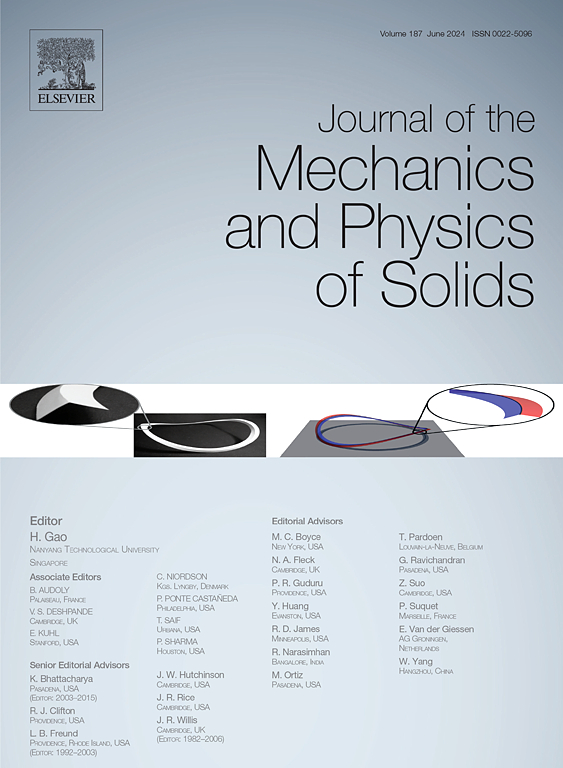热弹性各向异性和晶界取向偏差对陶瓷微裂纹的影响
IF 5
2区 工程技术
Q2 MATERIALS SCIENCE, MULTIDISCIPLINARY
引用次数: 0
摘要
本文用一个高效的计算框架研究了热弹性各向异性在脆性材料晶界开裂中的作用。计算了7种晶体体系中35种材料的能量释放率(ERRs)。考虑了两种裂纹几何形状:孤立双晶板中的短界面裂纹和由周期性六角形晶粒组成的多晶板中的晶界裂纹。裂纹驱动力的计算包括:穿透板厚(宽度等于六角形晶界长度的裂纹)、沿双晶界面延伸、从三结处出现的穿晶裂纹、以及在晶粒三结处扭成块状材料。高通量计算框架生成随机取向颗粒产生的ERRs的概率分布;多晶边缘裂纹的分布比双晶界面短裂纹的分布更宽。对不同晶粒结构的广泛研究也表明,只有相邻晶粒的前5-6环影响给定界面的裂纹驱动力。简要讨论了微裂纹观测解释、织构陶瓷性能量化和两相陶瓷复合材料设计的意义。本文章由计算机程序翻译,如有差异,请以英文原文为准。

The impacts of thermoelastic anisotropy and grain boundary misorientation on microcracking in ceramics
This paper examines the role of thermoelastic anisotropy on grain boundary cracking in brittle materials using a highly efficient computational framework. Energy release rates (ERRs) are computed for 35 materials spanning all seven crystal systems. Two crack geometries are considered: short interface cracks in isolated bicrystal plates, and cracked grain boundaries in polycrystal plates comprising periodic hexagonal grains. Crack driving forces are computed for penetration through the plate thickness (for cracks of width equal to the length of a hexagonal grain boundary), extension along bicrystal interfaces, transgranular cracks that emerge from triple junctions, and kinking into bulk materials and at grain triple junctions. The high throughput computational framework produces probability distributions for ERRs arising from randomly oriented grains; the distributions for cracks at grain edges in polycrystals are broader than those for short cracks along bicrystal interfaces. A broad study of different grain configurations also illustrates that only the first 5-6 rings of neighboring grains influence crack driving forces for a given interface. The implications for interpreting microcracking observations, quantifying the performance of textured ceramics, and designing two-phase ceramic composites are briefly discussed.
求助全文
通过发布文献求助,成功后即可免费获取论文全文。
去求助
来源期刊
CiteScore
9.80
自引率
9.40%
发文量
276
审稿时长
52 days
期刊介绍:
The aim of Journal of The Mechanics and Physics of Solids is to publish research of the highest quality and of lasting significance on the mechanics of solids. The scope is broad, from fundamental concepts in mechanics to the analysis of novel phenomena and applications. Solids are interpreted broadly to include both hard and soft materials as well as natural and synthetic structures. The approach can be theoretical, experimental or computational.This research activity sits within engineering science and the allied areas of applied mathematics, materials science, bio-mechanics, applied physics, and geophysics.
The Journal was founded in 1952 by Rodney Hill, who was its Editor-in-Chief until 1968. The topics of interest to the Journal evolve with developments in the subject but its basic ethos remains the same: to publish research of the highest quality relating to the mechanics of solids. Thus, emphasis is placed on the development of fundamental concepts of mechanics and novel applications of these concepts based on theoretical, experimental or computational approaches, drawing upon the various branches of engineering science and the allied areas within applied mathematics, materials science, structural engineering, applied physics, and geophysics.
The main purpose of the Journal is to foster scientific understanding of the processes of deformation and mechanical failure of all solid materials, both technological and natural, and the connections between these processes and their underlying physical mechanisms. In this sense, the content of the Journal should reflect the current state of the discipline in analysis, experimental observation, and numerical simulation. In the interest of achieving this goal, authors are encouraged to consider the significance of their contributions for the field of mechanics and the implications of their results, in addition to describing the details of their work.

 求助内容:
求助内容: 应助结果提醒方式:
应助结果提醒方式:


